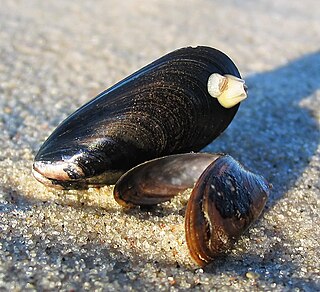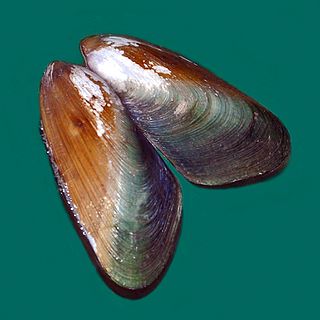
The Arcida is an extant order of bivalve molluscs. This order dates back to the lower Ordovician period. They are distinguished from related groups, such as the mussels, by having a straight hinge to the shells, and the adductor muscles being of equal size. The duplivincular ligament, taxodont dentition, and a shell microstructure consisting of the outer crossed lamellar and inner complex crossed lamellar layers are defining characters of this order.

Lithophaga, the date mussels, are a genus of medium-sized marine bivalve molluscs in the family Mytilidae. Some of the earliest fossil Lithophaga shells have been found in Mesozoic rocks from the Alps and from Vancouver Island.

Mytilidae are a family of small to large saltwater mussels, marine bivalve molluscs in the order Mytilida. One of the genera, Limnoperna, inhabits brackish or freshwater environments. The order has only this one family which contains some 52 genera.
Cardita is a genus of marine bivalve molluscs in the family Carditidae.

Perna perna, the brown mussel, is an economically important mussel, a bivalve mollusc belonging to the family Mytilidae. It is harvested as a food source but is also known to harbor toxins and cause damage to marine structures. It is native to the waters of Africa, Europe, and South America and was introduced in the waters of North America.

Mytilus is a cosmopolitan genus of medium to large-sized edible, mainly saltwater mussels, marine bivalve molluscs in the family Mytilidae.

Modiolus, the horsemussels, are a genus of medium-sized marine bivalve molluscs in the family Mytilidae.

The Mediterranean mussel is a species of bivalve, a marine mollusc in the family Mytilidae. It is an invasive species in many parts of the world, and also an object of aquaculture.

Perna is a genus of mussels, marine bivalve molluscs in the family Mytilidae.

Bathymodiolus thermophilus is a species of large, deep water mussel, a marine bivalve mollusc in the family Mytilidae, the true mussels. The species was discovered at abyssal depths when submersible vehicles such as DSV Alvin began exploring the deep ocean. It occurs on the sea bed, often in great numbers, close to hydrothermal vents where hot, sulphur-rich water wells up through the floor of the Pacific Ocean.

Mytilus coruscus, common name the Korean mussel or the hard-shelled mussel, is a species of mussel, a marine bivalve mollusc in the family Mytilidae. This species is heavily exploited as a food item via mariculture in Korea and in China.

Modiolus albicostus is a species of "horse mussel", a marine bivalve mollusc in the family Mytilidae, the mussels.

Neotrigonia margaritacea, common name the pearly brooch-shell, is a species of saltwater clam, a marine bivalve mollusc in the family Trigoniidae. This species is known from sandy substrates in shallow seas in southeastern and southwestern Australia. This species was the first member of the family to be discovered alive; previous to its discovery, trigoniids were only known from fossils.

Mytella is a genus of saltwater clams, marine bivalve molluscs in the family Mytilidae, the mussels.

Mytella guyanensis is a species of saltwater clams, marine bivalve molluscs in the family Mytilidae, the mussels.

Choromytilus is a genus of mussel, a marine bivalve mollusc in the family Mytilidae.

Choromytilus chorus, common name Chorus mussel or Choro mussel, is a species of mussel, a marine bivalve mollusc in the family Mytilidae.

Modiolus americanus, or the bearded horse-mussel a species of bivalve mollusc in the family Mytilidae. It is found in New Zealand. Its shell typically is 90 millimetres (3.5 in).

Adipicola pelagica is a species of saltwater clam, a marine bivalve mollusc in the family Mytilidae, the mussels. It is a deepwater species and is found attached to the bones and tissues of whales that have died and sunk to the seabed, and sometimes to fragments of decomposing carcases which have sloughed off and floated to the surface.

Septifer is a genus of saltwater clams, marine bivalve molluscs in the family Mytilidae, the mussels.

















